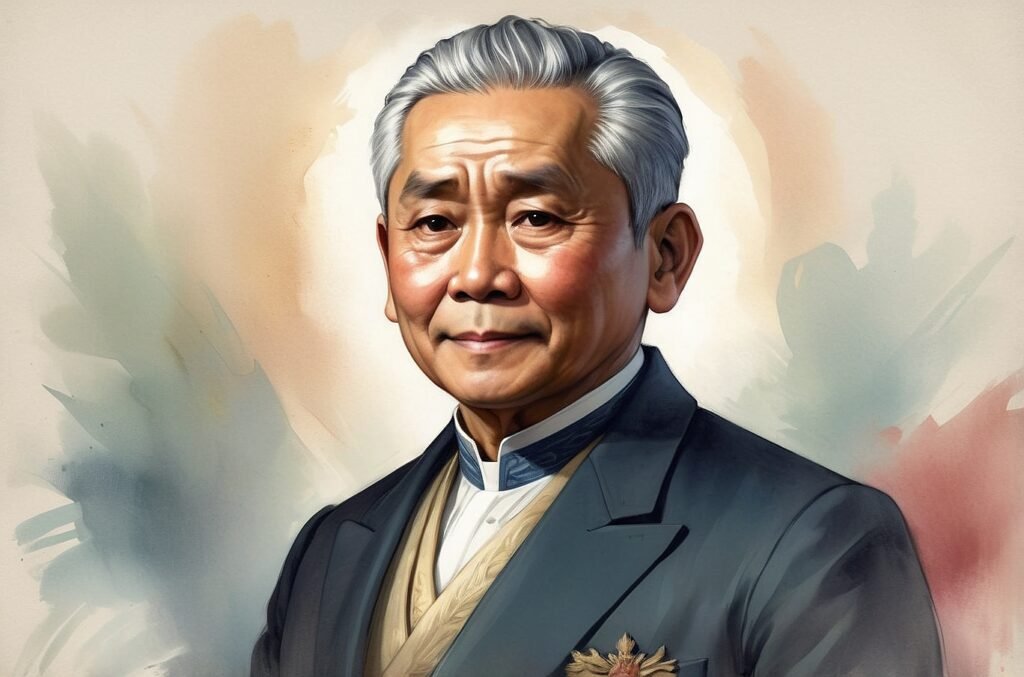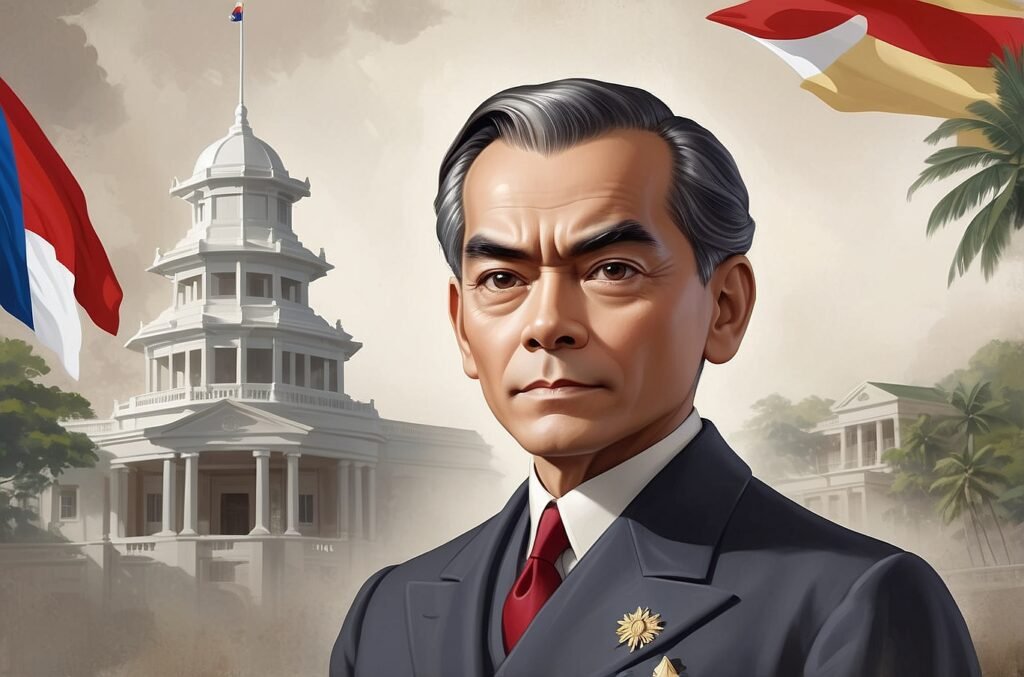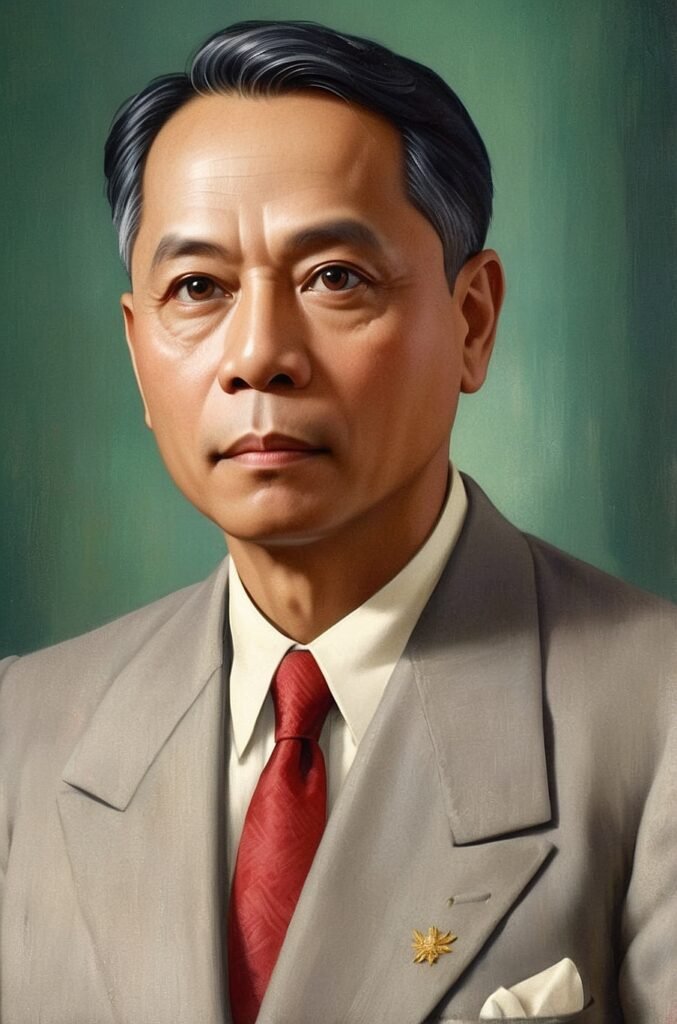Sergio Osmeña, a pivotal figure in Philippine history, was born on September 9, 1878, in Cebu City, Philippines. His early years were marked by a blend of privilege and determination, setting the stage for his future political career. Osmeña’s father, Don Pedro Osmeña y Saliling, was a prominent shopkeeper, while his mother, Juana Suico Osmeña, came from a well-respected family in Cebu. This background provided young Sergio with opportunities that were rare for many Filipinos during the Spanish colonial period.
Osmeña’s educational journey was both impressive and formative. He began his studies at the Colegio de San Carlos in Cebu, where he demonstrated exceptional academic prowess. His thirst for knowledge and intellectual capabilities led him to pursue higher education in Manila. At the prestigious University of Santo Tomas, Osmeña studied law, laying the foundation for his future career in politics and public service. His time at the university not only honed his legal acumen but also exposed him to the political currents of the time, including the growing nationalist sentiment among educated Filipinos.
Academic Achievements:
- Graduated with honors from Colegio de San Carlos
- Completed law degree at the University of Santo Tomas
- Passed the bar examination with high marks in 1903
The turn of the century brought significant changes to the Philippines, with the transition from Spanish to American colonial rule. This period coincided with Osmeña’s emergence into public life, armed with his education and a deep understanding of both Filipino society and the new colonial administration. His ability to navigate these complex political waters would prove crucial in his ascent to leadership roles in the coming years.
Political Career and Rise to Prominence
Sergio Osmeña’s political career began in earnest in the early 1900s, a time of significant transition for the Philippines. His entry into politics was marked by a rapid ascent through various positions of increasing responsibility and influence. In 1904, at the young age of 26, Osmeña was elected governor of Cebu, becoming the youngest provincial governor in Philippine history. This early success was a testament to his political acumen and the trust he had already garnered among his constituents.
Osmeña’s tenure as governor was characterized by his focus on infrastructure development and educational reforms. He initiated projects to improve roads, bridges, and public buildings, while also advocating for increased access to education for Cebuanos. These priorities would remain central themes throughout his political career, reflecting his belief in the importance of development and education in nation-building.
Key Political Positions:
| Year | Position |
|---|---|
| 1904 | Governor of Cebu |
| 1907 | Speaker of the Philippine Assembly |
| 1922 | Senator |
| 1935 | Vice President of the Commonwealth |
In 1907, Osmeña’s political career took a significant leap forward when he was elected as the first Speaker of the Philippine Assembly. This position placed him at the forefront of Philippine politics during the American colonial period. As Speaker, Osmeña worked tirelessly to advance Filipino interests within the constraints of the colonial system. He advocated for greater autonomy and pushed for policies that would prepare the Philippines for eventual independence.
Osmeña’s leadership style was marked by pragmatism and a willingness to work within the existing political framework to achieve gradual progress towards independence. This approach sometimes put him at odds with more radical nationalists, but it allowed him to maintain a productive relationship with American authorities while steadily advancing Filipino interests.
Throughout the 1920s and early 1930s, Osmeña continued to play a pivotal role in Philippine politics. He served as a Senator and was a key figure in negotiations with the United States regarding Philippine independence. His diplomatic skills and deep understanding of both Filipino and American perspectives made him an invaluable asset in these discussions.
Vice Presidency and World War II
In 1935, with the establishment of the Commonwealth of the Philippines, Sergio Osmeña assumed the role of Vice President under President Manuel L. Quezon. This period marked a crucial transition for the Philippines, as the Commonwealth was designed to serve as a preparatory stage for full independence. Osmeña’s experience and political savvy made him an ideal partner for Quezon in navigating this complex political landscape.
The Quezon-Osmeña administration faced numerous challenges, including the need to develop national institutions, prepare for economic independence, and address social issues. Osmeña played a significant role in these efforts, often taking charge of specific policy areas and representing the Philippines in international forums. His work during this period further solidified his reputation as a statesman and a key architect of the future independent Philippines.
Key Events During Osmeña’s Vice Presidency:
- Implementation of the National Language Act (1937)
- Establishment of the National Economic Protectionism Association (1938)
- Negotiations for the revision of the Bell Trade Act
The outbreak of World War II in 1941 dramatically altered the course of Philippine history and Osmeña’s political journey. As Japanese forces invaded the Philippines, the Commonwealth government was forced into exile. President Quezon, Vice President Osmeña, and other key officials evacuated to the United States, where they continued to operate as a government-in-exile.
During this period of exile, Osmeña worked tirelessly to maintain international support for the Philippines and to plan for the eventual liberation and reconstruction of the country. He participated in numerous diplomatic missions and maintained close contact with Allied leaders, ensuring that the Philippine cause remained a priority in the broader context of the war in the Pacific.
The strain of leadership in exile took its toll on President Quezon’s health. As Quezon’s condition deteriorated, Osmeña prepared to assume greater responsibilities. On August 1, 1944, following Quezon’s death, Sergio Osmeña became the second President of the Commonwealth of the Philippines, facing the monumental task of leading a nation still under enemy occupation.
Presidency and Post-War Challenges
Sergio Osmeña’s ascension to the presidency in August 1944 came at a critical juncture in Philippine history. As the second President of the Commonwealth, he inherited a nation ravaged by war and facing the daunting task of reconstruction. Osmeña’s presidency was characterized by his efforts to restore democracy, rebuild the country’s infrastructure, and navigate the complex political landscape of the immediate post-war period.
One of Osmeña’s first major challenges was to oversee the liberation of the Philippines from Japanese occupation. Working closely with American forces led by General Douglas MacArthur, Osmeña returned to the Philippines in October 1944, landing with MacArthur at Leyte. This symbolic return marked the beginning of the end of Japanese occupation and the start of the arduous process of rebuilding the nation.
Key Initiatives During Osmeña’s Presidency:
- Reconstruction Efforts: Prioritized the rebuilding of war-damaged infrastructure, including roads, bridges, and public buildings.
- Economic Recovery: Implemented policies to stabilize the economy and attract foreign investment for reconstruction.
- Education Reform: Focused on reopening schools and universities, recognizing education’s role in national recovery.
- Political Reforms: Worked to restore democratic institutions and prepare for the transition to full independence.
Osmeña’s presidency was marked by a pragmatic approach to governance. He understood the need for continued cooperation with the United States while also asserting Philippine sovereignty. This delicate balance was reflected in his handling of issues such as the presence of U.S. military bases and economic agreements between the two nations.
One of the most significant challenges Osmeña faced was the issue of collaboration during the Japanese occupation. He had to navigate the complex task of reconciling the nation while also addressing calls for justice against those who had cooperated with the occupying forces. His approach was generally one of moderation, seeking to balance the need for accountability with the imperative of national unity.
The table below summarizes some of the key events and policies during Osmeña’s presidency:
| Year | Event/Policy |
|---|---|
| 1944 | Return to the Philippines with General MacArthur |
| 1945 | Liberation of Manila and major urban centers |
| 1945 | Establishment of the Foreign Service of the Philippines |
| 1946 | Negotiations for the Bell Trade Act |
| 1946 | Preparations for Philippine Independence |
Despite his efforts and experience, Osmeña faced significant political challenges towards the end of his term. The emergence of new political forces, including those led by Manuel Roxas, presented strong opposition. In the 1946 presidential election, the first since before the war, Osmeña made the unusual decision not to campaign actively for re-election, stating that he wanted the people to decide freely without the influence of presidential pressure.
Legacy and Historical Significance
Sergio Osmeña’s legacy in Philippine history is multifaceted and enduring. As a key figure in the transition from colonial rule to independence, Osmeña played a crucial role in shaping the political landscape of the modern Philippines. His career, spanning over four decades, left an indelible mark on the nation’s journey towards self-governance and democracy.
One of Osmeña’s most significant contributions was his role in the development of Philippine democratic institutions. From his early days as governor of Cebu to his tenure as Speaker of the Philippine Assembly and eventually as President, Osmeña consistently worked to strengthen the foundations of democratic governance. His commitment to the rule of law and constitutional processes set important precedents for future leaders.
Key Aspects of Osmeña’s Legacy:
- Advocate for Independence: Throughout his career, Osmeña was a steady voice for Philippine independence, working within the system to gradually increase autonomy.
- Diplomatic Skill: His ability to negotiate effectively with American authorities helped secure favorable terms for the Philippines in various agreements.
- Economic Development: Osmeña’s policies laid the groundwork for post-war economic recovery and development.
- Educational Reform: His emphasis on education as a tool for national development influenced Philippine educational policy for generations.
- Political Mentorship: Many future Philippine leaders were influenced by Osmeña’s political style and philosophy.
Osmeña’s approach to governance, characterized by pragmatism and moderation, had a lasting impact on Philippine politics. His ability to work within existing systems while pushing for gradual change became a model for many Filipino politicians in the post-independence era. This approach, while sometimes criticized by more radical elements, allowed for steady progress and helped maintain stability during crucial transitional periods.
In the realm of foreign relations, Osmeña’s legacy is particularly noteworthy. His experience in dealing with American authorities and his role in negotiating the terms of Philippine independence set the tone for Philippine-American relations in the post-war period. The relationships he cultivated and the diplomatic skills he honed proved invaluable in securing support for the Philippines during the critical years of reconstruction.
Osmeña’s commitment to democracy was perhaps most poignantly demonstrated in his approach to the 1946 presidential election. His decision not to campaign actively, citing a desire to let the people choose freely, set a powerful example of democratic principles in action. Although this decision may have contributed to his electoral defeat, it reinforced his reputation as a statesman who placed the interests of democracy above personal political gain.
In the years following his presidency, Osmeña remained an elder statesman, offering counsel and perspective to subsequent generations of Filipino leaders. His experiences and insights, spanning from the late Spanish colonial period through the tumultuous years of World War II and into the era of independence, provided a unique historical perspective that continued to influence Philippine politics long after his active involvement had ended.
A Statesman for the Ages
Sergio Osmeña’s life and career encapsulate a critical period in Philippine history. From his early days as a young governor to his role as the second President of the Commonwealth, Osmeña was a central figure in the Philippines’ journey from colony to independent nation. His legacy is one of steady leadership, pragmatic governance, and unwavering commitment to Philippine democracy and independence.
Osmeña’s political career, spanning over four decades, witnessed the transformation of the Philippines through multiple colonial regimes, a world war, and the challenges of post-war reconstruction. Through it all, he maintained a vision of a free and democratic Philippines, working tirelessly to bring that vision to fruition. His ability to navigate complex political waters, both domestically and internationally, helped lay the groundwork for the modern Philippine state.
The impact of Osmeña’s leadership extends far beyond his time in office. His emphasis on education, economic development, and democratic institutions continue to influence Philippine policy and governance to this day. Future generations of Filipino leaders have looked to Osmeña’s example of statesmanship and principled leadership as a model to emulate.
As we reflect on Sergio Osmeña’s contributions to Philippine history, we are reminded of the importance of visionary leadership, diplomatic skill, and unwavering commitment to democratic principles in nation-building. His legacy serves as a testament to the power of steady, principled leadership in guiding a nation through periods of profound change and challenge.
In an era of rapid global change and evolving democratic challenges, the life and career of Sergio Osmeña offer valuable lessons for contemporary leaders and citizens alike. His story is not just a chapter in Philippine history, but a compelling example of leadership in the face of national transformation, one that continues to resonate and inspire in the Philippines and beyond.
Disclaimer: This blog post is based on historical records and widely accepted information about Sergio Osmeña and the history of the Philippines. While every effort has been made to ensure accuracy, historical accounts can sometimes vary. Readers are encouraged to cross-reference with other reputable sources for a comprehensive understanding. If you notice any inaccuracies, please report them so we can promptly make corrections and maintain the integrity of this historical account.




